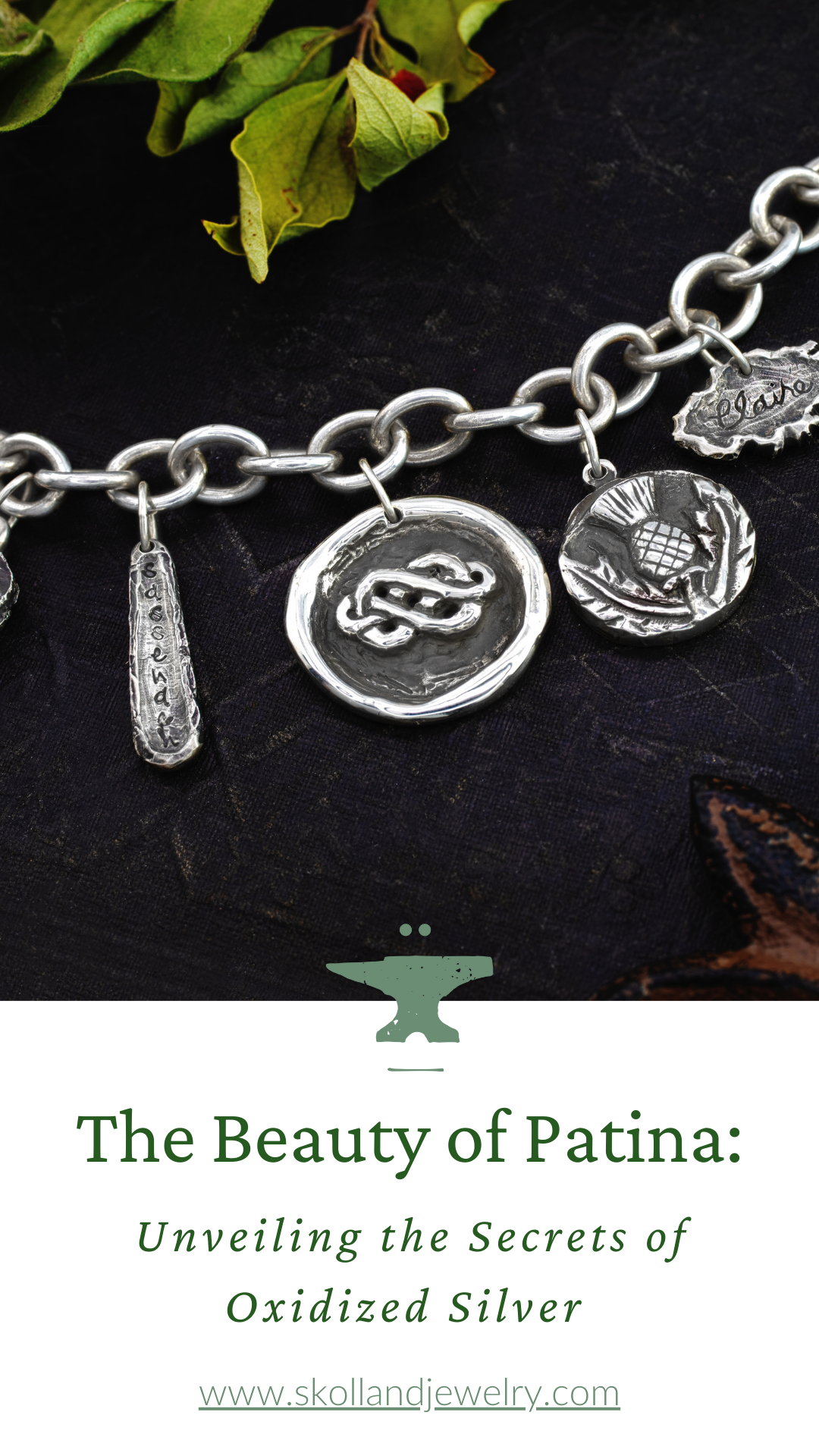The Beauty of Patina: Unveiling the Secrets of Oxidized Silver
In the world of jewelry, there are few things more captivating than the mysterious allure of oxidized silver. This unique process has a timeless appeal that has enchanted both wearers and admirers for centuries.
In this article, we explore the secrets behind the process that turns your favorite silver pieces into darkened contrasting works of art with depth and dimension and delve into the history of silver patina and the process of silver patination.
Oxidized silver has been intentionally treated to encourage the natural process of tarnishing, creating a beautiful, antique finish with a dark, rich hue. This distinctive appearance makes it an incredibly popular choice for those seeking pieces that either emulate historical relics or provide contrasting tones for art jewelry with particular themes such as gothic, brutalist or fantasy jewelry.
As we explore the world of oxidized silver and patina jewelry, we reveal the fascinating history behind this remarkable metal and how it has evolved. From its ancient origins to its modern-day popularity, oxidized silver has a story that is as captivating as the jewelry it adorns.

What is Oxidized Silver?
When we talk about oxidized silver, we are referring to sterling silver that has undergone a chemical process to encourage the natural tarnishing that occurs when silver is exposed to certain elements and/or time. This process, known as oxidation, results in a dark, antique finish that appears on the surface of silver and base metal alloys containing copper. Oxidized silver is also commonly known as blackened sterling silver, darkened sterling silver, or patinated sterling silver. Natural oxidization cannot occur on fine silver (also known as pure silver, or 999) because there is no copper present in fine silver, but it can occur in sterling silver alloys and coin silver alloys due to the presence of copper. The copper in these alloys is a double-edged sword - it gives strength to the silver, allowing it to be durable enough for jewelry making and everyday wear, but it causes the jewelry to tarnish over time (or rapidly, depending on the concentration) in the presence of certain conditions such as moisture or sweat.
This copper composition allows the silver to develop a rich, dark patina, creating a distinctive appearance that sets it apart from fine silver. In the world of jewelry, oxidized silver is sought after for its unique aesthetic appeal and the depth of character it brings to each piece.
In comparison to other finishes on silver, such as polished or brushed, oxidized silver is usually defined by its dark, antique color but it can also take on other colors such as blue, red, green, brown, or golden hues in some controlled cases. The blackened appearance is achieved through a process that quickly oxidizes the copper present on the surface of the jewelry. Other color appearances are the result of adding additional chemicals to a diluted oxidizing solution to develop the desired color instead of going straight to gray or black tones.

The Process of Silver Patination
The process of silver patination is an intriguing one, involving a delicate balance of chemistry and craftsmanship. This process begins with a sterling silver alloy composed primarily of silver and a small percentage of copper. When this alloy is exposed to elements, such as oxygen and sulfur, a natural reaction occurs, causing the surface of the metal to darken and develop a patina.
To encourage this process, jewelers or metalsmiths often use a variety of techniques to speed up the oxidation of the metal. One common method involves the use of liver sulfur, which accelerates the tarnishing process and allows for the development of a controlled, even patina. By carefully monitoring the reaction and adjusting the solution as needed, jewelers can achieve a wide range of hues and finishes, from a subtle gold or brown, to a deep gray or black.
Once the desired patina has been achieved, the jewelry is often sealed with a protective coating such as wax or lacquer to preserve the color. This aids in repelling moisture and oils that might strip or change the patina, allowing the finish to remain in place longer with proper care.
Can Oxidized Sterling Silver Get Wet and Does Silver Rust?
One of the most common questions about oxidized sterling silver is whether it can get wet, and if it causes the silver to rust. The answer to both of these questions lies in the unique properties of silver and the nature of the oxidation process.
Unlike metals such as iron, silver does not rust when exposed to water. Instead, the moisture can cause the silver to tarnish more quickly, resulting in a darker patina. While this may not be an issue for some, it can be a concern for those who wish to preserve the original appearance of colored patinas (golden, brown, green, blue, etc.)
In general, it is best to avoid exposing your oxidized sterling silver jewelry to water, as this can potentially damage the protective coating applied to the surface of the metal. To ensure the longevity and beauty of your oxidized silver pieces, it is recommended that you remove them before swimming, bathing, or engaging in activities that may cause them to encounter water or abrasive elements like sand or steel. It is also advisable to not rub the darkened areas, as your skin oils can strip the patina or wear away the protective seal.
The Unique Beauty of Oxidized Sterling Silver
The allure of oxidized sterling silver lies in its unique beauty and the depth of character it brings to each piece of jewelry. From its dark, antique finish to the intricate details that are accentuated by the patina, oxidized silver has a captivating appeal that is timeless, and regal and can sometimes make a piece look like a relic.
One of the most striking aspects of oxidized sterling silver is how the patina highlights the intricate details and textures of a piece of jewelry. The dark, rich hues of the patina create a beautiful contrast against the bright silver, drawing the eye to every curve and contour of the piece. This creates a depth and contrast that is difficult to achieve in other types of metal, other coatings, enamel, and platings can mimic the look of patina, but none can replicate the gradient appearance that natural patina can provide under the right circumstances. Oxidization is also easy to reapply if you have found that your piece’s appearance has changed over time or with wear, replacing plating can be costly.
Another unique characteristic of oxidized sterling silver is its versatility. Whether you prefer bold statement pieces or delicate, understated jewelry, there is an oxidized silver piece that will suit your style. From chunky rings and bracelets to delicate necklaces and earrings, oxidized silver is found in a wide range of styles, making it a perfect choice for any occasion.
A Brief History of Patina & Oxidized Metals
The ancient Egyptians and Romans use a technique called Niello to produce a patina-like effect on silver and gold pieces. Niello is substantially different than patina, it is applied more like an enamel but that is a story for another day. Niello produces an effect like patina or oxidization, only it is more metallic in appearance than the usual matte or shiny appearance of most patinas. During the Renaissance period, interest in patinated bronze and brass pieces increased, and interest in patinated silver sparked in the 1840s among French and German silversmiths. In addition, the Art Nouveau and Art Deco movements helped cement the desire for darkened jewelry, and patinated silver that is still popular today.
Oxidized Silver Care Tips
The first step in caring for your oxidized silver jewelry is to handle it with care.
- When removing your jewelry, be sure to do so gently, taking care not to scratch or damage the surface of the metal. It is also important to store your jewelry in a cool, dry place, away from direct sunlight and sources of heat or humidity-such as in a jewelry box, or a small plastic bag.
- When it comes to cleaning oxidized silver, it is essential to use a gentle approach that will not damage the patina or strip away the protective coating that has been applied to the metal. This means avoiding abrasive materials, such as polishing cloths or silver dips, which can remove the patina and alter the appearance of your jewelry.
- If cleaning with mild soap and warm water, carefully clean around the darkened areas of the ring taking care not to rub or scratch the darkened areas of the piece. Once the jewelry has been cleaned, carefully rinse it with warm water and pat it dry with a clean, soft cloth to prevent water spots from forming
Conclusion
In conclusion, oxidized sterling silver is a unique and captivating material that has enchanted wearers and admirers alike for centuries. The process of silver patination, combined with the careful craftsmanship of skilled jewelers, creates a depth and complexity that cannot be found with other types of finishes. Whether you prefer bold statement pieces or delicate, understated jewelry, oxidized sterling silver is a beautiful and timeless choice that will never go out of style.
Love the look of oxidized silver? Explore our signature patina pieces and find the one that speaks to your style.
Sources:
Judy Rudoe – Metal Plating & Patination, 1993
Alessandro Pacini – The Niello of Naturalis Historia, 2006
S. Field & S.F. Bonney – The Chemical Colouring of Metals, 1925
Want more care tips? Read our full guide on how to care for patina jewelry.

